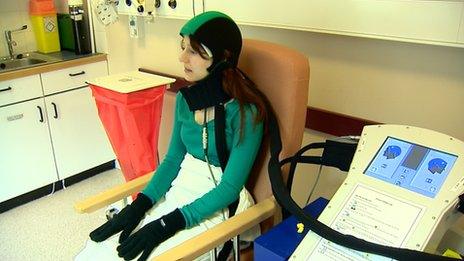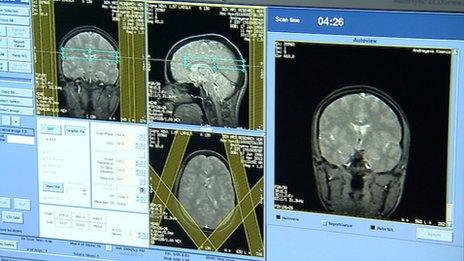Cap 'cools' brain for stroke trial
- Published

PhD student Kate Andreyeva was the first volunteer to have her brain temperature monitored
Volunteers in Edinburgh are having their brains cooled as part of a trial of a new treatment for stroke.
Healthy people are testing a cooling cap as part of a European project to see if cooling the body shortly after a stroke reduces damage to the brain.
About 1,000 Europeans die from a stroke every day, with twice as many being left disabled.
The Eurohype study will find out whether therapeutic hypothermia could be used to improve survival.
The technique is already used to improve survival in a variety of people at risk of brain injury, including newborn babies and cardiac patients.
Prof Malcolm Macleod, head of experimental neuroscience at the University of Edinburgh's Centre for Clinical Brain Sciences, said: "We think that it may be that within all of our cells there are really quite primitive protective mechanisms that protect us from rapid changes in temperature.
"We think that what we might be able to do is reawaken those processes in the brains of patients who have had strokes to protect their brain cells until such time as the body's own repair mechanisms can kick in and have their effect."
Stroke patients in other parts of Europe are already being cooled as part of the £9.5m four-year study.

Prof Malcolm Macleod is testing out methods of cooling the brain
Professor Macleod is testing out methods of cooling the brain, and hopes a cooling cap already in use for cancer patients may be a solution.
"We know it's able to cool the scalp because it's used with cancer patients to prevent hair loss. What we're trying to find out is whether it also cools the brain underneath the scalp.
"If it does that, it's something we could potentially use to treat stroke patients," he said.
PhD student Kate Andreyeva was the first volunteer to have her brain temperature monitored as she wore the cap for three hours.
"It feels slightly cold but it feels cold mainly in my neck and only slightly in my head," she said.
"I'm not shivering. It's like sitting in the park in winter without a hat. This study is really interesting and I'm glad I could help in some way."
Ambulance crews
Results from previous pilot studies suggest that reductions in the brain temperature of as little as 1C could be beneficial and may contribute to significantly reduced mortality rates and improved quality of life for stroke survivors.
The trial is aiming for a target temperature of between 34C and 35C compared to a normal body temperature of about 37C.

Reductions in the brain temperature of as little as 1C could be beneficial
Damage to the brain occurs at a temperature of around 31C which would be difficult, if not impossible, to achieve with the techniques being used.
The advantage of brain cooling is that the process could be started by ambulance crews.
"We think that brain cooling could be as effective as clot-busting drugs but it will be applicable to a much wider range of patients, so the potential benefit would be substantially higher because it's a treatment which we can deliver to more patients," said Prof Macleod.
"We think the lower we can get the brain temperature, the more beneficial the treatment will be."
Martin Waleij, CEO of Dignitana, the maker of the Dignicap, said they were already working on a model for use with stroke patients.
He said: "What we're using here is just to show proof of concept, but we're also developing a completely new cap which is portable, which should be able to be used in the back of an ambulance. So we could start cooling the patient very, very quickly - three to four hours before other technologies."